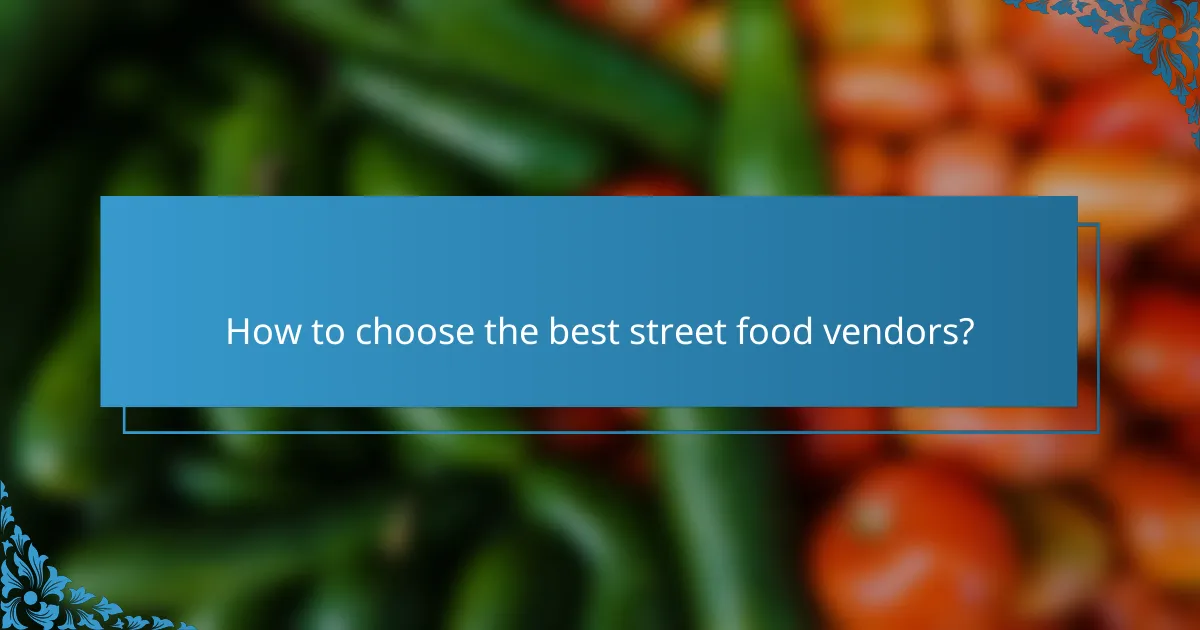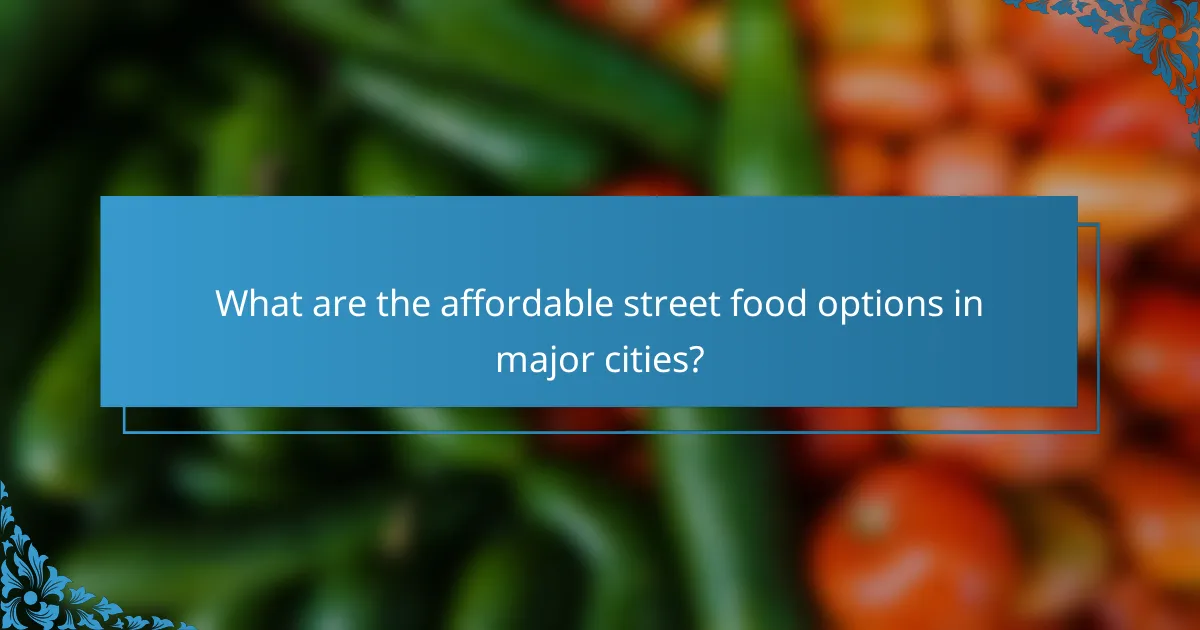Street food cuisine is a gateway to authentic flavors and rich cultural experiences, offering a delightful array of affordable options. From bustling food trucks to local vendors, each dish tells a story of tradition and community, inviting you to explore the diverse culinary landscape. Indulging in popular favorites like Tacos al pastor, Pad Thai, and Arepas not only satisfies your taste buds but also connects you to the vibrant cultures they represent.

Where to find authentic street food in Los Angeles?
Los Angeles is a vibrant hub for authentic street food, offering a diverse array of flavors and cultural experiences. From food trucks to local vendors, the city provides affordable options that reflect its rich culinary landscape.
Popular food trucks
Food trucks are a staple of the Los Angeles street food scene, serving everything from gourmet tacos to fusion dishes. Many trucks operate in popular areas like downtown and near major events, making them accessible for a quick bite. Check social media for real-time locations and menus, as many trucks change their spots frequently.
Some renowned food trucks include Kogi BBQ, known for its Korean-Mexican fusion, and The Lobos Truck, which offers mouthwatering gourmet burgers. Expect to pay around $10 to $15 for a meal, making it a budget-friendly option.
Local street vendors
Local street vendors contribute to the authenticity of Los Angeles’ street food culture, often selling traditional dishes passed down through generations. You can find vendors at markets, parks, and busy intersections, offering items like elote (grilled corn) and tamales.
When trying food from street vendors, look for those with a line of customers, as this usually indicates quality and popularity. Prices typically range from a few dollars for snacks to around $10 for more substantial meals.
Neighborhood food festivals
Neighborhood food festivals are excellent opportunities to explore a variety of street food options in Los Angeles. Events like the Smorgasburg LA and the LA Street Food Fest showcase numerous vendors, allowing you to sample different cuisines in one location.
These festivals often feature live music and entertainment, enhancing the cultural experience. Admission fees can vary, but many festivals offer free entry, with food items priced between $5 and $15. Keep an eye on local event calendars to catch upcoming festivals throughout the year.

What are the best street food dishes to try?
The best street food dishes offer authentic flavors, cultural experiences, and affordable options. Popular choices include Tacos al pastor, Pad Thai, and Arepas, each representing unique culinary traditions and ingredients.
Tacos al pastor
Tacos al pastor are a beloved Mexican street food, featuring marinated pork cooked on a vertical spit, similar to shawarma. The meat is typically seasoned with a blend of spices and pineapple, giving it a sweet and savory flavor profile.
When enjoying Tacos al pastor, look for vendors who slice the meat fresh and serve it on soft corn tortillas. Common toppings include onions, cilantro, and a squeeze of lime, enhancing the overall taste. Prices usually range from a couple of dollars to around five USD per taco, making it an affordable treat.
Pad Thai
Pad Thai is a famous Thai stir-fried noodle dish known for its balance of sweet, sour, and savory flavors. Made with rice noodles, eggs, tofu or shrimp, and a mix of vegetables, it is often garnished with peanuts and lime.
When trying Pad Thai from street vendors, ensure it is freshly prepared and served hot. Prices typically range from 50 to 100 Thai Baht, depending on the location and ingredients used. Look for stalls with high customer turnover for the best quality.
Arepas
Arepas are a staple in Venezuelan and Colombian street food, made from ground maize dough. These versatile corn cakes can be grilled, baked, or fried and are often filled with a variety of ingredients such as cheese, meats, or avocado.
To enjoy Arepas, seek out vendors who offer a range of fillings and toppings. Prices can vary, generally ranging from 1,000 to 5,000 Colombian Pesos or Venezuelan Bolivars, depending on the size and complexity of the filling. Freshly made Arepas provide a satisfying and flavorful experience.

How to experience street food culture?
Experiencing street food culture involves immersing yourself in local culinary traditions through various interactive activities. Engaging with the community and tasting authentic dishes enhances your understanding of the culture and its flavors.
Join guided food tours
Guided food tours offer a structured way to explore street food, led by knowledgeable locals who share insights about the dishes and their origins. These tours typically last a few hours and can range from affordable options to more premium experiences, often costing between $30 to $100 per person.
When choosing a food tour, consider the types of cuisine you want to explore and the reputation of the tour company. Look for reviews and recommendations to ensure a quality experience, and don’t hesitate to ask about dietary accommodations if needed.
Attend local cooking classes
Participating in local cooking classes allows you to learn how to prepare traditional street food dishes. Classes usually last a few hours and can cost anywhere from $50 to $150, depending on the location and complexity of the dishes.
Look for classes that include a market visit, where you can select fresh ingredients. This hands-on experience not only teaches you cooking techniques but also deepens your appreciation for the flavors and cultural significance of the food.
Visit cultural street fairs
Cultural street fairs are vibrant events that showcase local cuisine, music, and art. These fairs often feature numerous food stalls, allowing you to sample a variety of street foods in one location. Admission is typically free, but food prices can vary widely, often ranging from a few dollars to around $20 for more elaborate dishes.
Check local event calendars to find upcoming fairs and consider attending during peak times for the best selection. Engaging with vendors can provide insights into the dishes and the stories behind them, enhancing your overall experience.

What are the health and safety standards for street food?
Health and safety standards for street food vary by location but generally focus on preventing foodborne illnesses and ensuring safe food handling practices. Vendors must comply with local regulations that often include proper food storage, sanitation, and regular health inspections.
Local health department regulations
Local health departments establish regulations that street food vendors must follow to ensure public safety. These regulations typically cover food handling, preparation, and storage practices, requiring vendors to maintain cleanliness and proper cooking temperatures. In many regions, vendors are required to obtain permits and undergo inspections to verify compliance with these standards.
For example, in the United States, the FDA Food Code provides guidelines that many states adopt, which include specific temperature controls for hot and cold foods, as well as requirements for handwashing facilities. Vendors should familiarize themselves with their local health codes to avoid penalties and ensure safe food practices.
Best practices for food safety
To ensure food safety, street food vendors should implement best practices that minimize the risk of contamination. This includes using separate utensils for raw and cooked foods, regularly sanitizing surfaces, and ensuring that food is kept at safe temperatures. Vendors should also be trained in food safety principles to recognize potential hazards.
Additionally, maintaining proper hygiene is crucial. Vendors should wash their hands frequently, especially after handling raw ingredients or using the restroom. A simple checklist for food safety could include checking food temperatures, cleaning surfaces regularly, and ensuring proper waste disposal.

How to choose the best street food vendors?
To choose the best street food vendors, look for signs of popularity, cleanliness, and positive feedback. High customer turnover, online reviews, and observing food preparation practices can guide your choices effectively.
Look for high customer turnover
High customer turnover is a strong indicator of quality in street food vendors. When a stall has a steady stream of customers, it often means the food is fresh and well-liked. Aim for vendors that consistently attract a crowd, especially during peak meal times.
Consider visiting during busy hours to gauge how quickly food is being prepared and served. A long line can indicate that the food is worth the wait, while a lack of customers may suggest otherwise.
Check online reviews
Online reviews provide valuable insights into the experiences of previous customers. Platforms like Yelp or Google Reviews can help you identify vendors with a strong reputation for taste and hygiene. Look for vendors with a high rating and numerous reviews for a more reliable assessment.
Pay attention to comments about specific dishes, as well as any mentions of food safety practices. A vendor praised for their cleanliness and flavor is likely a good choice.
Observe food preparation practices
Observing how food is prepared can reveal a lot about a vendor’s standards. Look for vendors who maintain a clean cooking area and use fresh ingredients. Proper food handling, such as wearing gloves and keeping raw and cooked foods separate, is essential for safety.
Take note of how food is stored and displayed. Vendors who keep their ingredients covered and at safe temperatures demonstrate a commitment to food safety, which can enhance your overall dining experience.

What are the affordable street food options in major cities?
Affordable street food options in major cities offer a variety of authentic flavors and cultural experiences at budget-friendly prices. These options typically include local specialties that reflect the culinary traditions of the area, making them a popular choice for both locals and tourists.
Popular Street Food Choices
In many major cities, street food vendors serve a range of popular dishes that are both delicious and economical. For instance, in Bangkok, you can find Pad Thai and Som Tum for just a few dollars, while in Mexico City, tacos al pastor are a staple that can cost less than a dollar each. These dishes not only satisfy hunger but also provide a taste of local culture.
Where to Find Street Food
Street food can often be found in bustling markets, food stalls, and busy street corners. In cities like New York, food trucks offer diverse options from various cuisines, while in Mumbai, you can explore local bazaars for authentic snacks like vada pav and pav bhaji. Look for areas with high foot traffic, as these spots tend to have the freshest offerings.
Tips for Enjoying Street Food
When trying street food, prioritize vendors with a high turnover of customers, as this usually indicates freshness. It’s also wise to observe the cleanliness of the stall and the food preparation process. If you’re unsure about a dish, ask locals for recommendations or opt for popular items that are frequently ordered.
Health Considerations
While street food is generally safe to eat, it’s important to be mindful of hygiene. Choose vendors who cook food in front of you and avoid items that have been sitting out for long periods. Drinking bottled water and steering clear of raw foods can help prevent foodborne illnesses, especially in regions where sanitation practices may vary.
